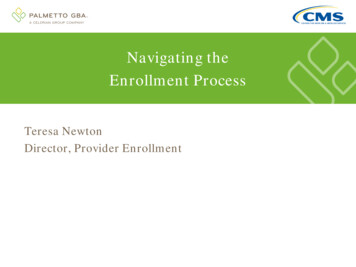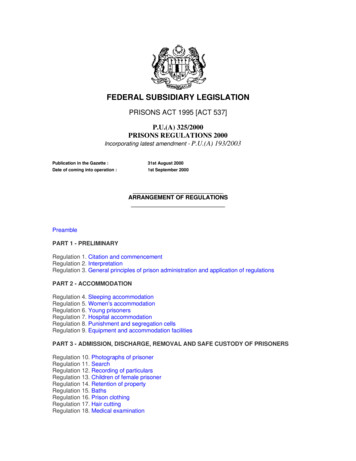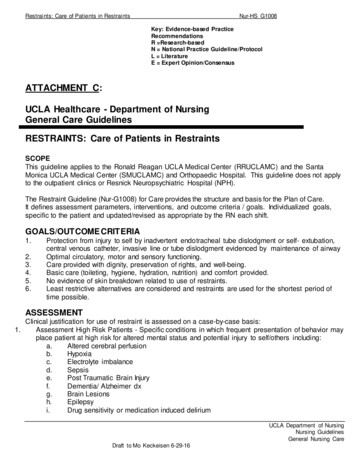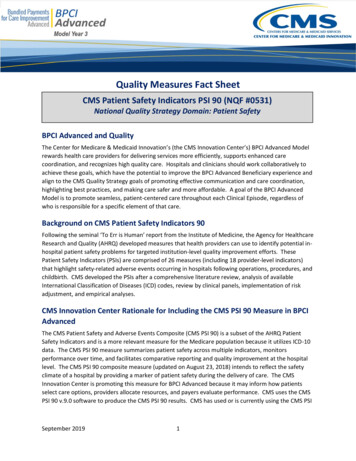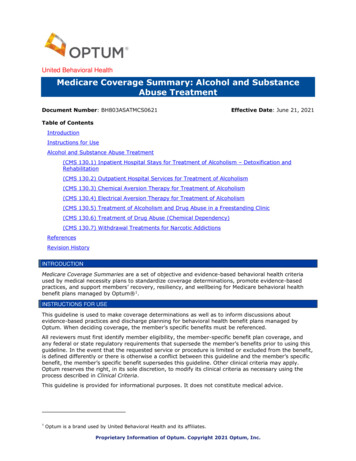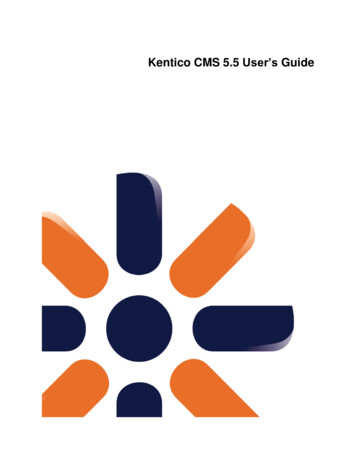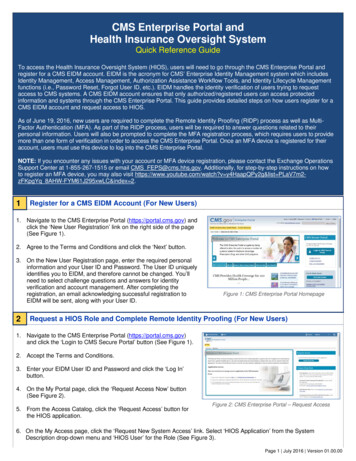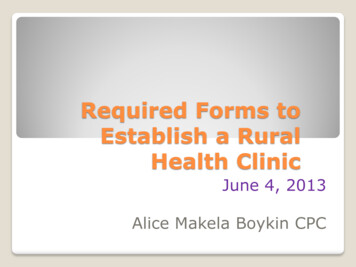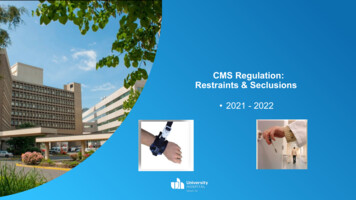
Transcription
CMS Regulation:Restraints & Seclusions 2021 - 2022Department of Public Affairs
CMS Condition of Participation Standard482.13 (e)Patient Rights: Restraint or SeclusionAll patients have the right to be free from physical or mental abuse, andcorporal punishment. All patients have the right to be free from restraintor seclusion, of any form, imposed as a means of coercion, discipline,convenience, or retaliation by staff. Restraint or seclusion may only beimposed to ensure the immediate physical safety of the patient, a staffmember, or others and must be discontinued at the earliest possibletime.Department of Public AffairsCMS regulation: restraints & seclusion revised 5/2021
Definition of Restraint & Seclusion A restraint is any manual method, physical or mechanical device, material, or equipment that immobilizes orreduces the ability of a patient to move his/her arms, legs, or head freely; or A drug or medication when it is used as a restriction to manage the patient’s freedom of movement and is nota standard treatment or dosage for the patient’s condition. A restraint does NOT include devices, such as orthopedically prescribed devices, surgical dressings orbandages, protective helmets, or other methods that involve the physical holding of a patient for the purposeof conducting routine physical exams or tests, or to protect the patient from falling out of bed, or to permit thepatient to participate in activities with the risk of physical harm (not a physical escort). Seclusion is the involuntary confinement of a patient alone in a room or area from which the patient isphysically prevented from leaving. Seclusion may only be used for the management of violent or selfdestructive behavior.Source: t of Public Affairs
Use of Restraint or Seclusion Must be in accordance with a written modification to the patient’s plan of care Implemented in accordance with hospital policy and State law Must be in accordance with the order of a physician or other LIP who is responsible for the care of the patient, andauthorized by policy and State law Orders for restraints or seclusion must never be written as a standing order or on an as needed basis (PRN) The attending must be consulted ASAP if the attending physician did not write the restraint or seclusion orderFact: It is ILLEGAL for nurses to maintain the use of restraints after the order has expired.Source: t of Public Affairs
UH Policy # 831-200-096Use of Restraints for Non-Violent or Non-Self Destructive BehaviorPurpose:To identify when restraints may be utilized and outline the procedure for the safe application, mandatory assessment, andappropriate notification of patients restrained.University Hospital is committed to creating an environment that minimizes circumstances that give rise to restraint and maximizessafety.Orders: The LIP/Primary Physician will: If the LIP who initially gives the order for the restraint is not the primary physician, he/she will notify the primaryphysician as soon as possible.o The LIP will request consent when clinically feasibleo The LIP will document this notification in the patient’s medical record. Discuss with staff the physical and psychological status of the patient, including changes to the patient's plan ofcare and treatment. Conduct and document face-to-face assessment within one (I) hour of restraint placement. Determine whether restraint should be continued. Provide the order for restraint. Conduct a face-to-face patient reassessment every twenty-four (24) hours and renew the order, if appropriate.You can access the entire policy at this link iew/2948Department of Public Affairs
UH Policy # 831-200-096Use of Restraints for Non-violent or Non-self Destructive Behavior (continued)Orders: The initial order will include:! Date and time restraint was initiated! Alternatives attempted! Specific rationale/justification (example: pulling out tubes/ dressings) Order must be time limited, not to exceed 24 hours Type of restraint Behavioral criteria for discontinuation of restraint, if applicable Restraints are used with adequate and appropriate justification, documentation and regard for patient safety! The RN will either apply or be present to supervise the application of restraints! To ensure patient safety:o The patient’s head should be free to rotate side to side.o Elevate the head of bed if patient is restrained in supine positiono Never fasten restraints to moveable items, such as side rails or wheels.o Only use mechanical devices that are specifically commercially manufactured for the purpose of physical restraint.o Only nursing staff trained in the safe application and removal of restraints may apply or remove restraints under the directionof an RN.You can access the entire policy at this link iew/2948Department of Public Affairs
UH Policy # 831-200-096Use of Restraints for Non-violent or Non-self Destructive Behavior (continued)– The interventions chosen for use are safely and appropriately implemented– When restraint is indicated, the least restrictive device shall be chosen The re-evaluation and renewal orders will include:– Documentation of the LIP face-to-face re-assessment every twenty-four (24) hours and renew or discontinue order.– If the order expires, the restraint should be discontinued, and the LIP contacted for reassessment/reevaluation.– If the restraint is discontinued and the patient requires the restraint to be reinstituted, a new order must be obtained.o A temporary, directly supervised release for the purpose of caring for the patient's needs such as feeding, turning,toileting, bathing or performing range of motion (ROM); is NOT considered a discontinuation of a restraint. The decision to discontinue the restraints can be done by the RN or LIP– The RN or LIP will assess if the behavior or condition that was the basis for the restraint order has been resolved or if theneeds of the patient can be met with less restrictive methods.– The RN will notify the LIP when there is improvement in the patient's condition and discontinue the order.– The RN will record the time and date that restraints are discontinued.You can access the entire policy at this link iew/2948Department of Public Affairs
UH Policy # 831-200-451Restraints and Seclusion for Violent or Self-Destructive BehaviorPurpose:To identify when restraints and/or seclusion for violent or self-destructive behavior may be utilized and outline the procedure for the safeapplication, mandatory assessment, and appropriate notification of patients restrained or in seclusion.Orders: Restraints and/or seclusion can be initiated as follows: An individual written order by the LIP; or An RN in response to an unanticipated or emergent situationo When an RN initiates restraints and/or seclusion they must:" Immediately after placing patient in restraints and/or seclusion, notify and consult with the LIP and obtain an order. (Verbal orders arenot allowed) The LIP will: Discuss with staff the physical and psychological status of the patient, including:o Patient’s immediate situationo Patient’s reaction to interventiono Changes to the patient’s plan of care and treatment Conduct and document face-to-face assessment within one (1) hour of restraint placement and/or seclusiono If the patient is released from restraint or seclusion prior to the face to face evaluation is conducted, the LIP is still required tosee the patient one (1) hour after the initiation of restraints and/or seclusionYou can access the full policy at this link iew/2438Department of Public Affairs
UH Policy # 831-200-451Restraints and Seclusion for Violent or Self-Destructive Behavior (continued)– Determine whether restraint/seclusion should be continued.– Provide the order for restraint. The initial order will include:– Date and time restraint was initiated– Alternatives attempted– Specific rationaleo Acute Specific rationale must be documented (Violent – Self destructive )– Maximum length of time for use of restrainto Orders for restraint/seclusion for Violent or Self-Destructive behaviors are limited to 1, 2, or 4 hours, dependingon patient’s age:i. Four (4) hours for adults (18 years and older)ii. Two (2) hours for children and adolescents ages 9 - 17 years oldiii. One (1) hour for children under age of 9Seclusion is only used within the service of psychiatry– Behavioral criteria for discontinuation of restraint, if applicableYou can access the full policy at this link iew/2438Department of Public Affairs
UH Policy # 831-200-451Restraints and Seclusion for Violent or Self-Destructive Behavior (continued)– Restraints are used with adequate and appropriate justification, documentation and regard for patient safety– The interventions chosen for use are safely and appropriately implemented– When restraint is indicated, the least restrictive device shall be chosen The re-evaluation and renewal orders will include:– The LIP must do a face-to-face re-assessment with every restraint or seclusion renewal.– If the order expires, the restraint should be discontinued and the LIP contacted for reassessment/reevaluation.– If the restraint is discontinued and the patient requires the restraint to be reinstituted, a new order must be obtained.o A temporary, directly supervised release for the purpose of caring for the patient’s needs such as feeding, turning, toileting,bathing or performing range of motion (ROM); is NOT considered a discontinuation of a restraint. The decision to discontinue the restraints and/or seclusion can be done by the RN or LIP.– The RN or LIP will assess if the behavior or condition that was the basis for the restraint order has been resolved or if theneeds of the patient can be met with less restrictive methods.– The RN will notify the LIP when there is improvement in the patient’s condition and discontinue the order.– The RN will record the time and date that restraints and/or seclusion are discontinued.You can access the full policy at this link iew/2438Thank YouDepartment of Public Affairs
CMS Condition of Participation Standard CMS regulation: restraints & seclusion revised 5/2021 482.13 (e) Patient Rights:Restraint or Seclusion All patients have the right to be free from physical or mental abuse, and corporal punishment. All patients have the right to be free from restraint

